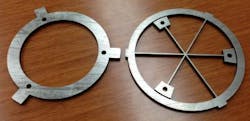| A mirror mount containing flexures is made of bulk metallic glass. This mount is intended for space optics. (Image: NASA/JPL-Caltech) |
Researchers at NASA's Jet Propulsion Laboratory (JPL; Pasadena, CA), Brigham Young University (Provo, UT), and the California Institute of Technology (Caltech; Pasadena, CA) describe a new methodology for creating complex, low-cost compliant mechanisms (devices based on flexures) using a combination of novel materials and manufacturing techniques.1 They demonstrate that materials called bulk metallic glasses have highly desirable properties for these mechanisms. These glasses are actually metal alloys designed to have a random arrangement of atoms.
"We've demonstrated that these metals not only have desirable properties for applications where flexibility and durability are required, but can also be injection-molded like a plastic and made cheaply," says Douglas Hofmann, principal investigator of the research at JPL.
"Traditionally, titanium alloys have been used in compliant mechanisms because they were the best materials for the job, but titanium was also difficult to work with," says Larry Howell, professor at Brigham Young University and study co-author. The new research shows that bulk metallic glasses have twice the strength and conventional flexibility of titanium alloys, while also having low melting temperatures.
Although material scientists have been focusing on the 3D printing of titanium alloys, the new research shows that complex shapes can be molded at low cost, while maintaining their performance, when using bulk metallic glasses.
Bistable spring prototype
In the new study, the researchers modeled the performance of a number of compliant mechanisms and predicted that bulk metallic glasses would be the highest performing material in those applications, typically doubling the predicted performance of titanium. To verify the model, a bistable spring was made out of both titanium and metallic glass and mechanically tested to show the benefits. The researchers then worked with two commercial companies to fabricate more than 30 identical versions of the new mechanism, utilizing a new injection-molding technology.
The researchers also demonstrated the assembly of various bulk metallic glass components into a mirror mount (see figure).
"We hope that using these mechanisms in space will allow us to increase precision in our instruments and decrease their mass," Hofmann says. "They may also prove useful for storing elastic energy that can be used in space to deploy components without having to use motors."
Source: http://www.nasa.gov/jpl/news/metal-made-like-plastic-may-have-big-impact/#.VDaSmh_HmkA
REFERENCE:
1. Eric R. Homer et al., Advanced Engineering Materials (2014); doi: 10.1002/adem.201300566
